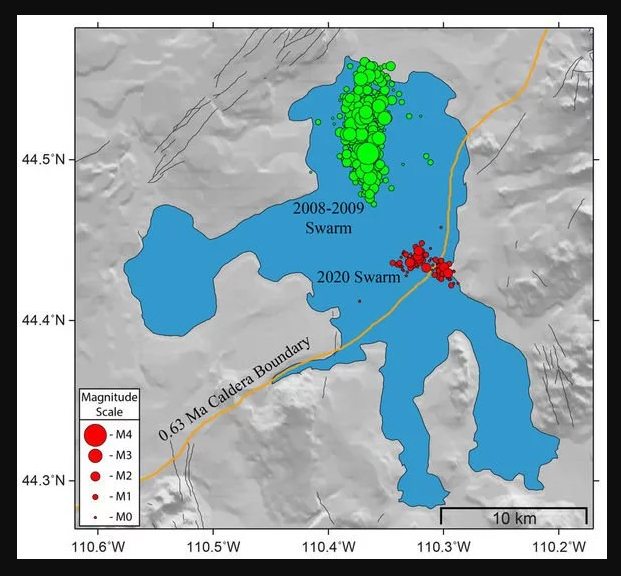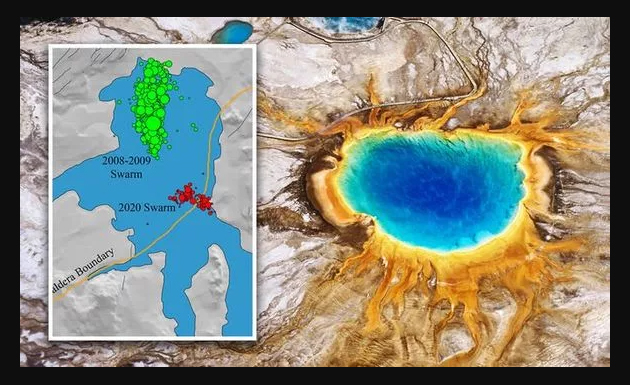O OVGA é um Centro de Ciência que desenvolve atividade de investigação aplicada e de divulgação científica na área da Vulcanologia, da Sismologia e da Geotermia.
Notícia -A A +A
Yellowstone volcano: Earthquake swarm strikes fault formed after last Yellowstone eruption
Notícia OVGA 15-12-2020

Yellowstone volcano: Stonger swarms have struck under Yellowstone Lake in the past (Image: USGS)
YELLOWSTONE volcano geologists have identified a cluster of earthquakes near the Yellowstone caldera boundary - a fault line that formed when the volcano erupted 631,000 years ago.
Yellowstone volcano is no stranger to earthquake swarms, with roughly 50 percent of seismicity in the region attributed to earthquake clusters. But a recently-tracked swarm of tremors has hit the US national park deep under Yellowstone Lake - a 110 square mile body of water that is cut in half by the Yellowstone Caldera boundary. The boundary is a fault line of the present-day caldera that formed about 631,000 years ago after Yellowstone's most recent explosive event.
The so-called Lava Creek eruption shaped some of the park's modern features, carving out a caldera measuring about 34 by 45 miles.
The caldera was also shaped by two previous events: the Huckleberry Ridge eruption 2.1 million years ago and the Mesa Falls eruption 1.3 million years ago.
In all three cases, the caldera was the product of the Yellowstone supervolcano erupting monstrous quantities of volcanic material, ash, debris and then collapsing in on itself.
Starting on December 1 and lasting until at least December 7, seismic stations in the Yellowstone region observed a swarm of earthquakes beneath the eastern part of Yellowstone Lake, right on the caldera boundary.

Yellowstone volcano: An earthquake swarm struck the Yellowstone caldera boundary this month (Image: USGS/GETTY)
Although stronger swarms have been recorded in the past, between December 2008 and January 2009 for example, this swarm was "slightly larger" than average in terms of the number of tremors.
And according to Jamie Farrell, an assistant research professor with the University of Utah Seismograph Stations and Chief Seismologist of the Yellowstone Volcano Observatory (YVO), the swarm's location is of particular interest.
The Yellowstone expert said: "However, one interesting aspect of this swarm is that it is occurring directly on the boundary of Yellowstone Caldera - a fault which formed due to collapse of the surface during the most recent large explosive eruption 631,000 years ago.
"Could this swarm be a reactivation of that boundary fault?
"Only further research will be able to address that question, but swarms on caldera-bounding faults are relatively common."
Another big swarm struck the caldera boundary in September this year when 100 earthquakes were recorded in the space of just 24 hours.
Such events are typically triggered by pressurised liquids - scorching water, gasses and molten rock - moving through the planet's crust.
The September swarm occurred where the caldera boundary fault intersects a regional fault zone.
Faults are fractures or zones of fractures between two chunks of rock that move relative to one another.
Sometimes, the movement is rapid and manifests in the form of earthquakes.
Source: The Express UK

Adenda OVGA: location of Yellowstone, USA, Google Earth View®
